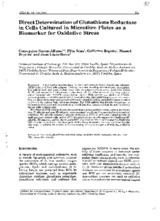Direct Determination of Glutathione Reductase in Cells Cultured in Microtitre Plates as a Biomarker for Oxidative Stress
Autor
García-Alfonso, Concepción
Sanz, Pilar
Repetto, Guillermo
Repetto, Manuel
López-Barea, Juan
Editor
Fund for the Replacement of Animals in Medical ExperimentsFecha
1995Materia
Vero cellsGlutathione reductase
Oxidative stress
Paraquat
Iron
METS:
Mostrar el registro METSPREMIS:
Mostrar el registro PREMISMetadatos
Mostrar el registro completo del ítemResumen
A new method was developed for the direct determination of glutathione reductase
(GOR) activity in Vero cells cultured in microtitre plates, avoiding cell-free extract preparation.
The cells in each well were washed twice with phosphate-buffered saline, lysed with Triton
X-100, and assayed in 0.1M potassium phosphate, pH 7.0. After subtracting oxidase activity,
which increased with NADPH concentration, the net GOR activity was similar at different
oxidised glutathione (GSSG) and NADPH concentrations, thus confirming enzyme saturation.
The optimised GOR assay used 2.5mM GSSG and 0.12mM NADPH; 5mM EDTA was also added
to prevent the enzyme from redox inactivation. The GOR activity was directly proportional to
the number of cells per well for a wide range of cell densities, thus supporting the assay's validity
for use with cultured cells.
The effects on GORactivity of three chemicals which induce oxidative stress, namely, paraquat,
iron (11) chloride and iron (111) chloride, were examined to validate the assay under experimental
conditions. The specific enzymatic activity increased to 357% of untreated control activity in
5mM paraquat-treated cells, and to 407% of control activity in cells exposed to 7.5mM iron (11)
chloride. By contrast, activity decreased to 56% of control activity in cells exposed to 5mM iron
(111) chloride. In conclusion, the changes in GOR activity detected in Vero cells confirm that the
new assay is suitable for routine in vitro screening of toxicants capable of inducing oxidative
stress.

